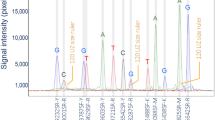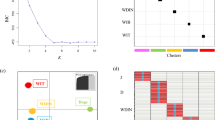Abstract
The ability to detect recent hybridization between dogs and wolves is important for conservation and legal actions, which often require accurate and rapid resolution of ancestry. The availability of a genetic test for dog–wolf hybrids would greatly support federal and legal enforcement efforts, particularly when the individual in question lacks prior ancestry information. We have developed a panel of 100 unlinked ancestry-informative SNP markers that can detect mixed ancestry within up to four generations of dog–wolf hybridization based on simulations of seven genealogical classes constructed following the rules of Mendelian inheritance. We establish 95 % confidence regions around the spatial clustering of each genealogical class using a tertiary plot of allele dosage and heterozygosity. The first- and second-backcrossed-generation hybrids were the most distinct from parental populations, with >90 % correctly assigned to genealogical class. In this article we provide a tool kit with population-level statistical quantification that can detect recent dog–wolf hybridization using a panel of dog–wolf ancestry-informative SNPs with divergent allele frequency distributions.



Similar content being viewed by others
References
Adams JR, Kelly BT, Waits LP (2003) Using faecal DNA sampling and GIS to monitor hybridization between red wolves (Canis rufus) and coyotes (Canis latrans). Mol Ecol 12(8):2175–2186
Akey JM, Ruhe AL, Akey DT, Wong AK, Connelly CF et al (2010) Tracking footprints of artificial selection in the dog genome. Proc Natl Acad Sci USA 107(3):1160–1165
Andersone Z, Lucchini V, Randi E, Ozolins J (2002) Hybridisation between wolves and dogs in Latvia as documented using mitochondrial and microsatellite DNA markers. Mamm Biol 67:79–90
Barton NH (2000) Estimating multilocus linkage disequilibria. Heredity 84:373–389
Bohling J, Waits L (2011) Assessing the prevalence of hybridization between sympatric Canis species surrounding the red wolf (Canis rufus) recovery area in North Carolina. Mol Ecol 20(10):2142–2156
Boyko AR, Quignon P, Li L, Schoenebeck JJ, Degenhardt JD et al (2010) A simple genetic architecture underlies morphological variation in dogs. Plos biol 8(8):e1000451
Fain S, Straughan D, Taylor B (2010) Genetic outcomes of wolf recovery in the western Great Lakes states. Conserv Genet 11(5):1747–1765
Fredrickson R, Hedrick P (2006) Dynamics of hybridization and introgression in red wolves and coyotes. Conserv Biol 20(4):1272–1283
Germonpre M, Sablin M, Stevens R, Hedges R, Hofreiter M et al (2008) Fossil dogs and wolves from Palaeolithic sites in Belgium, the Ukraine and Russia: osteometry, ancient DNA and stable isotopes. J Archaeol Sci 36:473–490
Hedrick PW, Fredrickson RJ (2008) Captive breeding and the reintroduction of Mexican and red wolves. Mol Ecol 17(1):344–350
Jones P, Chase K, Martin A, Ostrander EA, Lark KG (2008) Single-nucleotide polymorphism-based association mapping of dog stereotypes. Genetics 179:1033–1044
Liew M, Pryor R, Palais R, Meadows C, Erali M et al (2004) Genotyping of single-nucleotide polymorphisms by high-resolution melting of small amplicons. Clin Chem 50(7):1156–1164
Lindblad-Toh K, Wade CM, Mikkelsen TS, Karlsson EK, Jaffe DB et al (2005) Genome sequence, comparative analysis and haplotype structure of the domestic dog. Nature 438(7069):803–819
Miller CR, Adams JR, Waits LP (2003) Pedigree-based assignment tests for reversing coyote (Canis latrans) introgression into the wild red wolf (Canis rufus) population. Mol Ecol 12:3287–3301
Parker HG, Kim LV, Sutter NB, Carlson S, Lorentzen TD et al (2004) Genetic structure of the purebred domestic dog. Science 304(5674):1160–1164
Parker HG, Kukekova AV, Akey DT, Goldstein O, Kirkness EF et al (2007) Breed relationships facilitate fine-mapping studies: a 7.8 kb deletion cosegregates with Collie eye anomaly across multiple dog breeds. Genome Res 17(11):1562–1571
Price A, Patterson N, Plenge R, Weinblatt M, Shadick N et al (2006) Principal components analysis corrects for stratification in genome-wide association studies. Nat Genet 38(8):904–909
Pritchard JK, Stephens M, Donnelly P (2000) Inference of population structure using multilocus genotype data. Genetics 155:945–959
Randi E (2008) Detecting hybridization between wild species and their domesticated relatives. Mol Ecol 17(1):285–293
Randi E, Lucchini V (2002) Detecting rare introgression of domestic dog genes into wild wolf (Canis lupus) populations by Bayesian admixture analyses of microsatellite variation. Conserv Genet 3:31–45
Randi E, Pierpaoli M, Beaumont M, Ragni B, Sforzi A (2001) Genetic identification of wild and domestic cats (Felis silvestris) and their hybrids using Bayesian clustering methods. Mol Biol Evol 18(9):1679–1693
Sablin M, Khlopachev G (2002) The earliest Ice Age dogs: evidence from Eliseevichi I. Curr Anthropol 45(5):795–819
Savolainen P, Zhang YP, Luo L, Lundeberg J, Leitner T (2002) Genetic evidence for an East Asian origin of domestic dogs. Science 298(5598):1610–1613
Tang H, Coram M, Wang P, Zhu X, Risch N (2006) Reconstructing genetic ancestry blocks in admixed individuals. Am J Hum Genet 79(1):1–12
Verardi A, Lucchini V, Randi E (2006) Detecting introgressive hybridization between free-ranging domestic dogs and wild wolves (Canis lupus) by admixture linkage disequilibrium analysis. Mol Ecol 15:2845–2855
Vilà C, Wayne RK (1999) Hybridization between wolves and dogs. Conserv Biol 13(1):195–198
Vilà C, Savolainen P, Maldonado JE, Amorim IR, Rice JE et al (1997) Multiple and ancient origins of the domestic dog. Science 276(5319):1687–1689
Vilà C, Walker C, Sundqvist A, Flagstad O, Andersone Z et al (2003) Combined use of maternal, paternal and bi-parental genetic markers for the identification of wolf-dog hybrids. Heredity 90(1):17–24
Vilà C, Seddon J, Ellegren H (2005) Genes of domestic mammals augmented by backcrossing with wild ancestors. Trends Genet 21(4):214–218
vonHoldt BM, Pollinger JP, Lohmueller KE, Han E, Parker HG et al (2010) Genome-wide SNP and haplotype analyses reveal a rich history underlying dog domestication. Nature 464:898–903
vonHoldt BM, Pollinger JP, Earl DA, Knowles JC, Boyko AR et al (2011) A genome-wide perspective on the evolutionary history of enigmatic wolf-like canids. Genome Res 21(8):1294–1305
Acknowledgments
EAO and HGP are supported by the intramural program of the National Human Genome Research Institute. We thank Daniel Greenfield for the verification PCR. We also thank the dog owners who generously donated samples.
Author information
Authors and Affiliations
Corresponding author
Electronic supplementary material
Below is the link to the electronic supplementary material.
Rights and permissions
About this article
Cite this article
vonHoldt, B.M., Pollinger, J.P., Earl, D.A. et al. Identification of recent hybridization between gray wolves and domesticated dogs by SNP genotyping. Mamm Genome 24, 80–88 (2013). https://doi.org/10.1007/s00335-012-9432-0
Received:
Accepted:
Published:
Issue Date:
DOI: https://doi.org/10.1007/s00335-012-9432-0




